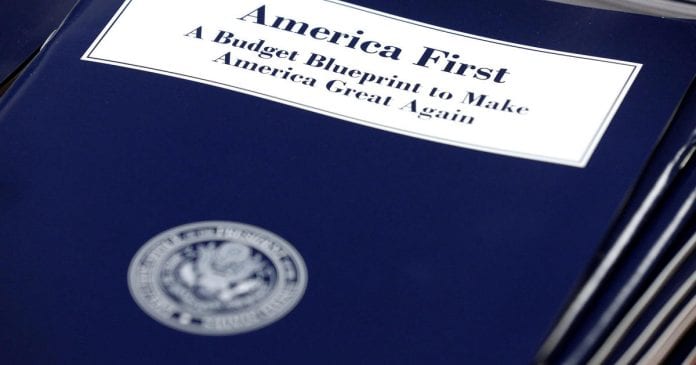The Trump Administration’s $4.4 trillion federal budget for next year takes some mean whacks to programs that affect fisheries.
Off the top, the spending plan unveiled on Feb. 12 cuts the budget for the National Oceanic and Atmospheric Administration by 20 percent to $4.6 billion. Among other things, NOAA manages the nation’s fisheries in waters from three to 200 miles offshore, which produce the bulk of Alaska’s seafood landings.
It’s the cuts within the cuts that reveal the most.
NOAA Fisheries is facing a $110.4 million drop to $837.3 million, a 14 percent budget cut. That includes a $17.7 million decrease in fisheries science and management, a $5 million cut in data collection needed for stock assessments, a $5.1 million reduction in funding for catch share programs and a $2.9 million cut to cooperative research programs.
The proposals for NOAA law enforcement are even more severe – a decline of $17.8 million is a 25 percent budget reduction.
“The entire law enforcement reduction is coming from the agency’s cooperative enforcement program and will eliminate funding for joint enforcement agreements with law enforcement partners from 28 states and U.S. territories,” reported the Gloucester Times.
The National Weather Service, also under NOAA’s umbrella, is facing a $75 million slice off its $1 billion budget. It will axe 355 jobs, more than a quarter of the NWS staff, including 248 forecasters.
Trump also wants to cut $4.8 million from habitat and conservation programs, wiping out funding and grants for NOAA’s fisheries habitat restoration projects.
The Trump plan proposes gutting $40 million from NOAA climate change programs, which would eliminate competitive grants for research and end studies on global warming in the Arctic, including predictions of sea-ice and fisheries in a changing climate.
The national Sea Grant College Program, which conducts research, training and education at more than 30 U.S. universities, is again on the chopping block.
Funding for programs under the U.S. Geological Survey that monitor earthquakes and volcanoes would each drop by 21 percent. The USGS water-resources program, which includes the national stream-gauge network, would be reduced 23 percent.
Trump proposes to cut the Environmental Protection Agency’s budget to $6.1 billion in 2019, its lowest level since the early 1990s and about 25 percent below the current mark.
The EPA budget also eliminates funding for climate-change research while providing $502 million for fossil energy research, an increase of nearly 24 percent.
Seafood sales also could be badly hurt by proposed deep cuts to food stamps, or Supplemental Nutrition Assistance Program (SNAP). Instead of shopping at grocery stores, under Trump’s plan recipients would receive boxes of shelf-stable commodity items such as powdered milk, juices, pasta, peanut butter, and canned meats, fruits and vegetables.
“Seafood is the only major food group that is not considered a USDA commodity. If the new food delivery platform is going to put an emphasis on commodity goods, then that will leave out lean, heart-healthy seafood,” said Linda Cornish, president of the Seafood Nutrition Partnership.
Closer to home, Trump also plans to stop federal funding for the Denali Commission, introduced by Congress in 1998 as an independent agency to provide critical utilities, infrastructure and economic support throughout Alaska. The plan calls for a $10 million cut out of $17 million, with the difference going to an “orderly closure.”
The White House says that any state that can afford to pay its residents an annual dividend doesn’t need a “unique and additional federal subsidy” such as the commission, wrote longtime Alaska journalist Dermot Cole. Trump added that “the commissions’ effectiveness at improving overall economic conditions remains unproven.”
The FY19 budget, which goes into effect on Oct. 1, now goes before Congress.
Rockfish releases save lives
More than 30 different kinds of rockfish are found in Alaska waters, though fewer than 10 species are commonly caught by recreational fishermen, mostly in Southeast Alaska. The fish are slow growing and can live well past 100 years.
“For yellow eye (red snapper) the age of first sexual maturity can be anywhere from 15-25 years old. So that has important implications for when these fish are harvested because many can be caught before they have the opportunity to reproduce even one time,” said Sam Hochholter, a sport fish biologist with the Alaska Dept. of Fish and Game.
Last month in Sitka the state Board of Fisheries voted to protect the fragile fish by requiring that in two years, all salt water sport anglers in Southeast must carry devices that safely release rockfish to the deep. On average, nearly 60,000 rockfish are caught in the Southeast sport fishery each year; about 5,000 are released.
When rockfish are reeled in, their swim bladders expand causing lethal injuries from the rapid decompression. The air-filled bladders also keep the fish afloat, thrashing about the surface.
“When you break them out of deep water they don’t have the ability to equalize the pressure,” explained Ace Calloway, a retired charter skipper from Valdez. “The bladder expands and pushes the eyes out the sockets and the stomach out their mouth. It’s a horrible looking site. They basically suffer the same thing a diver does that comes up too fast – what we normally call the bends.”
Callaway was the first to invent and patent a simple tool called the Black Tip catch and release recompression tool that gently lowers rockfish to the sea floor. Studies in Alaska and Oregon have proven that rockfish quickly returned to the depths can result in over 95 percent survival.
A state web page called “proper deepwater rockfish release” provides quick and easy techniques on making and using simple devices, such as weighted jigs or plastic milk cartons.
A rockfish release rule has been on the books for Alaska charter boats for six years. It will go into effect for sport anglers in two years to allow for more public education and outreach.














